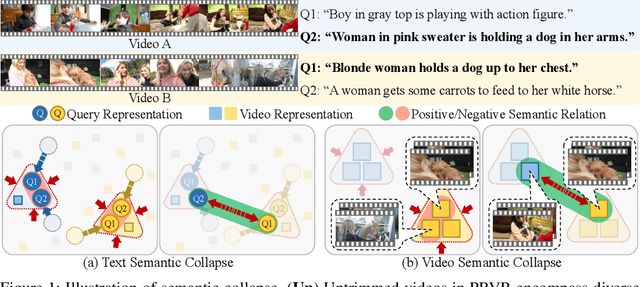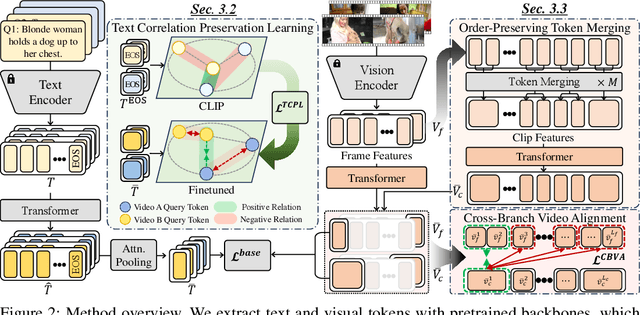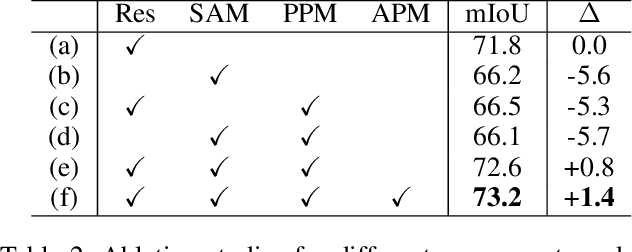Jae-Pil Heo
Auxiliary Descriptive Knowledge for Few-Shot Adaptation of Vision-Language Model
Dec 19, 2025



Abstract:Despite the impressive zero-shot capabilities of Vision-Language Models (VLMs), they often struggle in downstream tasks with distribution shifts from the pre-training data. Few-Shot Adaptation (FSA-VLM) has emerged as a key solution, typically using Parameter-Efficient Fine-Tuning (PEFT) to adapt models with minimal data. However, these PEFT methods are constrained by their reliance on fixed, handcrafted prompts, which are often insufficient to understand the semantics of classes. While some studies have proposed leveraging image-induced prompts to provide additional clues for classification, they introduce prohibitive computational overhead at inference. Therefore, we introduce Auxiliary Descriptive Knowledge (ADK), a novel framework that efficiently enriches text representations without compromising efficiency. ADK first leverages a Large Language Model to generate a rich set of descriptive prompts for each class offline. These pre-computed features are then deployed in two ways: (1) as Compositional Knowledge, an averaged representation that provides rich semantics, especially beneficial when class names are ambiguous or unfamiliar to the VLM; and (2) as Instance-Specific Knowledge, where a lightweight, non-parametric attention mechanism dynamically selects the most relevant descriptions for a given image. This approach provides two additional types of knowledge alongside the handcrafted prompt, thereby facilitating category distinction across various domains. Also, ADK acts as a parameter-free, plug-and-play component that enhances existing PEFT methods. Extensive experiments demonstrate that ADK consistently boosts the performance of multiple PEFT baselines, setting a new state-of-the-art across various scenarios.
Mitigating Semantic Collapse in Partially Relevant Video Retrieval
Oct 31, 2025



Abstract:Partially Relevant Video Retrieval (PRVR) seeks videos where only part of the content matches a text query. Existing methods treat every annotated text-video pair as a positive and all others as negatives, ignoring the rich semantic variation both within a single video and across different videos. Consequently, embeddings of both queries and their corresponding video-clip segments for distinct events within the same video collapse together, while embeddings of semantically similar queries and segments from different videos are driven apart. This limits retrieval performance when videos contain multiple, diverse events. This paper addresses the aforementioned problems, termed as semantic collapse, in both the text and video embedding spaces. We first introduce Text Correlation Preservation Learning, which preserves the semantic relationships encoded by the foundation model across text queries. To address collapse in video embeddings, we propose Cross-Branch Video Alignment (CBVA), a contrastive alignment method that disentangles hierarchical video representations across temporal scales. Subsequently, we introduce order-preserving token merging and adaptive CBVA to enhance alignment by producing video segments that are internally coherent yet mutually distinctive. Extensive experiments on PRVR benchmarks demonstrate that our framework effectively prevents semantic collapse and substantially improves retrieval accuracy.
White Aggregation and Restoration for Few-shot 3D Point Cloud Semantic Segmentation
Sep 17, 2025Abstract:Few-Shot 3D Point Cloud Segmentation (FS-PCS) aims to predict per-point labels for an unlabeled point cloud, given only a few labeled examples. To extract discriminative representations from the limited support set, existing methods have constructed prototypes using conventional algorithms such as farthest point sampling. However, we point out that its initial randomness significantly affects FS-PCS performance and that the prototype generation process remains underexplored despite its prevalence. This motivates us to investigate an advanced prototype generation method based on attention mechanism. Despite its potential, we found that vanilla module suffers from the distributional gap between learnable prototypical tokens and support features. To overcome this, we propose White Aggregation and Restoration Module (WARM), which resolves the misalignment by sandwiching cross-attention between whitening and coloring transformations. Specifically, whitening aligns the support features to prototypical tokens before attention process, and subsequently coloring restores the original distribution to the attended tokens. This simple yet effective design enables robust attention, thereby generating representative prototypes by capturing the semantic relationships among support features. Our method achieves state-of-the-art performance with a significant margin on multiple FS-PCS benchmarks, demonstrating its effectiveness through extensive experiments.
Translation of Text Embedding via Delta Vector to Suppress Strongly Entangled Content in Text-to-Image Diffusion Models
Aug 14, 2025Abstract:Text-to-Image (T2I) diffusion models have made significant progress in generating diverse high-quality images from textual prompts. However, these models still face challenges in suppressing content that is strongly entangled with specific words. For example, when generating an image of ``Charlie Chaplin", a ``mustache" consistently appears even if explicitly instructed not to include it, as the concept of ``mustache" is strongly entangled with ``Charlie Chaplin". To address this issue, we propose a novel approach to directly suppress such entangled content within the text embedding space of diffusion models. Our method introduces a delta vector that modifies the text embedding to weaken the influence of undesired content in the generated image, and we further demonstrate that this delta vector can be easily obtained through a zero-shot approach. Furthermore, we propose a Selective Suppression with Delta Vector (SSDV) method to adapt delta vector into the cross-attention mechanism, enabling more effective suppression of unwanted content in regions where it would otherwise be generated. Additionally, we enabled more precise suppression in personalized T2I models by optimizing delta vector, which previous baselines were unable to achieve. Extensive experimental results demonstrate that our approach significantly outperforms existing methods, both in terms of quantitative and qualitative metrics.
Selective Contrastive Learning for Weakly Supervised Affordance Grounding
Aug 11, 2025Abstract:Facilitating an entity's interaction with objects requires accurately identifying parts that afford specific actions. Weakly supervised affordance grounding (WSAG) seeks to imitate human learning from third-person demonstrations, where humans intuitively grasp functional parts without needing pixel-level annotations. To achieve this, grounding is typically learned using a shared classifier across images from different perspectives, along with distillation strategies incorporating part discovery process. However, since affordance-relevant parts are not always easily distinguishable, models primarily rely on classification, often focusing on common class-specific patterns that are unrelated to affordance. To address this limitation, we move beyond isolated part-level learning by introducing selective prototypical and pixel contrastive objectives that adaptively learn affordance-relevant cues at both the part and object levels, depending on the granularity of the available information. Initially, we find the action-associated objects in both egocentric (object-focused) and exocentric (third-person example) images by leveraging CLIP. Then, by cross-referencing the discovered objects of complementary views, we excavate the precise part-level affordance clues in each perspective. By consistently learning to distinguish affordance-relevant regions from affordance-irrelevant background context, our approach effectively shifts activation from irrelevant areas toward meaningful affordance cues. Experimental results demonstrate the effectiveness of our method. Codes are available at github.com/hynnsk/SelectiveCL.
Prototypes are Balanced Units for Efficient and Effective Partially Relevant Video Retrieval
Apr 17, 2025Abstract:In a retrieval system, simultaneously achieving search accuracy and efficiency is inherently challenging. This challenge is particularly pronounced in partially relevant video retrieval (PRVR), where incorporating more diverse context representations at varying temporal scales for each video enhances accuracy but increases computational and memory costs. To address this dichotomy, we propose a prototypical PRVR framework that encodes diverse contexts within a video into a fixed number of prototypes. We then introduce several strategies to enhance text association and video understanding within the prototypes, along with an orthogonal objective to ensure that the prototypes capture a diverse range of content. To keep the prototypes searchable via text queries while accurately encoding video contexts, we implement cross- and uni-modal reconstruction tasks. The cross-modal reconstruction task aligns the prototypes with textual features within a shared space, while the uni-modal reconstruction task preserves all video contexts during encoding. Additionally, we employ a video mixing technique to provide weak guidance to further align prototypes and associated textual representations. Extensive evaluations on TVR, ActivityNet-Captions, and QVHighlights validate the effectiveness of our approach without sacrificing efficiency.
Rethinking LayerNorm in Image Restoration Transformers
Apr 09, 2025Abstract:This work investigates abnormal feature behaviors observed in image restoration (IR) Transformers. Specifically, we identify two critical issues: feature entropy becoming excessively small and feature magnitudes diverging up to a million-fold scale. We pinpoint the root cause to the per-token normalization aspect of conventional LayerNorm, which disrupts essential spatial correlations and internal feature statistics. To address this, we propose a simple normalization strategy tailored for IR Transformers. Our approach applies normalization across the entire spatio-channel dimension, effectively preserving spatial correlations. Additionally, we introduce an input-adaptive rescaling method that aligns feature statistics to the unique statistical requirements of each input. Experimental results verify that this combined strategy effectively resolves feature divergence, significantly enhancing both the stability and performance of IR Transformers across various IR tasks.
Temporal Alignment-Free Video Matching for Few-shot Action Recognition
Apr 08, 2025



Abstract:Few-Shot Action Recognition (FSAR) aims to train a model with only a few labeled video instances. A key challenge in FSAR is handling divergent narrative trajectories for precise video matching. While the frame- and tuple-level alignment approaches have been promising, their methods heavily rely on pre-defined and length-dependent alignment units (e.g., frames or tuples), which limits flexibility for actions of varying lengths and speeds. In this work, we introduce a novel TEmporal Alignment-free Matching (TEAM) approach, which eliminates the need for temporal units in action representation and brute-force alignment during matching. Specifically, TEAM represents each video with a fixed set of pattern tokens that capture globally discriminative clues within the video instance regardless of action length or speed, ensuring its flexibility. Furthermore, TEAM is inherently efficient, using token-wise comparisons to measure similarity between videos, unlike existing methods that rely on pairwise comparisons for temporal alignment. Additionally, we propose an adaptation process that identifies and removes common information across classes, establishing clear boundaries even between novel categories. Extensive experiments demonstrate the effectiveness of TEAM. Codes are available at github.com/leesb7426/TEAM.
Fine-Tuning Visual Autoregressive Models for Subject-Driven Generation
Apr 03, 2025Abstract:Recent advances in text-to-image generative models have enabled numerous practical applications, including subject-driven generation, which fine-tunes pretrained models to capture subject semantics from only a few examples. While diffusion-based models produce high-quality images, their extensive denoising steps result in significant computational overhead, limiting real-world applicability. Visual autoregressive~(VAR) models, which predict next-scale tokens rather than spatially adjacent ones, offer significantly faster inference suitable for practical deployment. In this paper, we propose the first VAR-based approach for subject-driven generation. However, na\"{\i}ve fine-tuning VAR leads to computational overhead, language drift, and reduced diversity. To address these challenges, we introduce selective layer tuning to reduce complexity and prior distillation to mitigate language drift. Additionally, we found that the early stages have a greater influence on the generation of subject than the latter stages, which merely synthesize local details. Based on this finding, we propose scale-wise weighted tuning, which prioritizes coarser resolutions for promoting the model to focus on the subject-relevant information instead of local details. Extensive experiments validate that our method significantly outperforms diffusion-based baselines across various metrics and demonstrates its practical usage.
Foreground-Covering Prototype Generation and Matching for SAM-Aided Few-Shot Segmentation
Jan 01, 2025



Abstract:We propose Foreground-Covering Prototype Generation and Matching to resolve Few-Shot Segmentation (FSS), which aims to segment target regions in unlabeled query images based on labeled support images. Unlike previous research, which typically estimates target regions in the query using support prototypes and query pixels, we utilize the relationship between support and query prototypes. To achieve this, we utilize two complementary features: SAM Image Encoder features for pixel aggregation and ResNet features for class consistency. Specifically, we construct support and query prototypes with SAM features and distinguish query prototypes of target regions based on ResNet features. For the query prototype construction, we begin by roughly guiding foreground regions within SAM features using the conventional pseudo-mask, then employ iterative cross-attention to aggregate foreground features into learnable tokens. Here, we discover that the cross-attention weights can effectively alternate the conventional pseudo-mask. Therefore, we use the attention-based pseudo-mask to guide ResNet features to focus on the foreground, then infuse the guided ResNet feature into the learnable tokens to generate class-consistent query prototypes. The generation of the support prototype is conducted symmetrically to that of the query one, with the pseudo-mask replaced by the ground-truth mask. Finally, we compare these query prototypes with support ones to generate prompts, which subsequently produce object masks through the SAM Mask Decoder. Our state-of-the-art performances on various datasets validate the effectiveness of the proposed method for FSS. Our official code is available at https://github.com/SuhoPark0706/FCP
 Add to Chrome
Add to Chrome Add to Firefox
Add to Firefox Add to Edge
Add to Edge